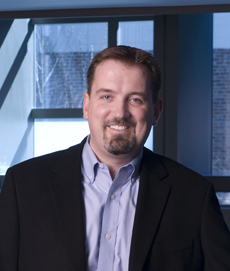Nanoscale Drug Delivery for Hard-to-Heal Tissues
by Lida Tunesi

Jason Burdick, professor in the department of Bioengineering, recently published a study with colleagues in the Perelman School of Medicine, the VA Medical Center, bioengineering graduate student Feini Qu, and Burdick lab alumna Julianne Holloway on a new method of repairing damaged tissue in the meniscus. Burdick’s research group develops and tests polymeric materials for a variety of uses in drug delivery and tissue regeneration.
In this study, published in Nature Communications, Burdick and collaborators tested a scaffold made of nanofibers that can be delivered to torn tissue in the meniscus and aid in healing. The dual-purpose scaffold contains both an enzyme to help open up the dense, extracellular matrix surrounding the meniscus tissue, as well as a growth factor that attracts new cells through the matrix and into the wound site.
The meniscus — the cartilage cushion between the meeting of the thighbone and the shinbone — can be torn during all kinds of activities that put pressure on or rotate the knee joint, such as shoveling snow or running. However, the dense extracellular matrix in deep tissues makes it difficult for injuries occurring in cartilage, tendons, and ligaments to heal themselves. Torn menisci are so common and so severe that the surgery required to repair the injury is the most common orthopedic procedure, and cases are on the rise. However, meniscus surgery may not be fully effective, since it involves removing only the torn part of a meniscus, leaving behind less of it to bear the same load of body weight as before.
Researchers at Penn are working to uncover ways to encourage the cells in and around the meniscus to repair themselves, hopefully leading to less invasive procedures. Scientists within the McKay Orthopaedic Research Laboratory are taking a tissue-engineering approach to improve many types of healing related to the skeletal system, says Lou Soslowsky, PhD, the vice chair for research in the department of Orthopaedic Surgery. “We blend biology with engineering to understand normal and pathologic processes to ultimately replace or regenerate musculoskeletal tissues.”
Continue reading at the Penn Medicine News Blog
